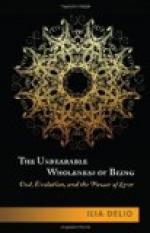Mary had now taken her place by the side of God, and was commonly addressed as divine. Anselm of Canterbury explains: “God is the Father of all created things, Mary the Mother of all things recreated.... God begat the creator of the world, Mary gave birth to its Saviour.” Peter of Blois declared that the Virgin was the only mediatress between Christ and humanity. “We were sinners and afraid of the wrath of the Father, for He is terrible; but we have the Virgin, in whom there is nothing terrible, for in her is the fulness of mercy and purity.” The twelfth century produced the Ave Maria, the angelic salutation, the principal prayer to Mary, which was introduced into all churches. The Italian Franciscan monk, Bonaventura, and Peter Damiani, were above all others instrumental in spreading the worship of the Virgin, and Damiani said of her: “To Thee has been given all power in heaven and on earth.” The fresco of the Camposanto at Pisa, ascribed to Orcagna, shows the transfigured Virgin sitting by the side of Christ, not below Him. The numerous legends in which Mary, often regardless of justice and propriety, delivers her faithful worshippers from all manner of dangers, were written during the same period. One of the most famous of these is the legend of Theophilus, the forerunner of Faust. In a German version (by Brun of Schoenebeck) dating from the thirteenth century, Theophilus abjures God and all things divine, with the sole exception of Mary, wherefore she saves him from eternal damnation. This poem therefore shows us Mary as absolutely opposed to God.
We have now arrived at the third stage of the cult of Mary; the new, spiritual love, translated into metaphysics, was projected on her; she was approached by her worshippers with the ardent love which hitherto had been the prerogative of earthly women. The two currents, the one arising in ecclesiastical tradition, and the other in the soul of the metaphysical lover, had met; the genuine spiritual cult of Mary was the creation of the great metaphysical lovers, who existed not only in the twelfth and thirteenth centuries, but are met not infrequently later on; man’s irresistible need to raise woman above him and worship her, created the true Madonna, for whose sake romantic souls of all times have “returned home” into the fold of the Church, the true Madonna who at heart is alien to the principles of the Church, but is re-born daily in the soul of the metaphysical lover. The hierarchy knew how to take advantage of and control this adoring love; the metaphysical lover raised his mistress above humanity and prayed before her shrine; religion said: “The celestial woman whom you may lovingly adore is here, with me. All you have to do is to call her by the name I have given her, and the kingdom of Heaven will be yours.”
But on the other hand Mary represents to-day, and doubtless will do for a long time to come, a dogmatically acknowledged deity, recognised by the spirit of Protestantism as a remnant of Paganism, and duly detested; the masses in Italy and Spain pray to-day to her image, as in bygone days the masses prayed to the images in Greek and Roman temples. This goddess is unchanging, and from the point of view of the psychologist uninteresting.




